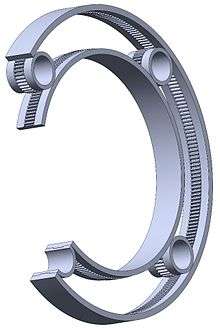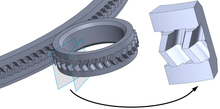Gear bearing




Gear bearing – a kind of rolling-elements bearing combining to epicyclic gear. It consist of bearing gearwheels, each of them is represented by concentric alternation of rollers and gearwheels with equal (pitch-) diameters; the widths of conjugated rollers and gearwheels in pairs are the same.
Engagement
In order to avoid misalignment, sticking and reduce sliding friction in bearing gearwheels engagements on adjacent end faces of their gearwheels and rollers, the teeth must be either made beveled and/or made with engagement by surfaces providing the efficient axial meshing. For the instance, the implementations of bearing gears with beveled teeth and rollers adjacent end faces as well as herringbone engagement with minimum axial shift due to opposite slopes of teeth are presented on pictures.
Work
Neglecting clearance and assuming perfect accuracy, engagement of bearing gears is aimed at maximum rolling with minimum sliding friction of conjugated profiles in movement. End rollers ensure limiting of gear radial shift at their contact points, thus, along with their engagement, slip-free rolling motion of their conjugated pairs is implemented. Adjacent end faces of teeth and rollers limit axial shift of conjugated bearing gears performing their plane-parallel motion. In such a way, using bearing gears as sun, ring and more than two satellites uniformly distributed among them the entire gear bearing is arranged, and carrier may be used instead of ring or sun gearwheels, or it may act as frame unit and transfer rotation from satellites, whereas limitation of carrier degrees of freedom would form redundant constraints or serve as additional basis for force distribution in mechanism. In case less than three bearing satellite gearwheels are involved, at least axles of movable sun and/or of ring bearing gearwheels should be fixed relative to housing parts.
Usage
Gear bearings could be used as more efficient bearing as planetary gear mechanism with simplified kinematic relations and/or suspension, also in double row planetary gear and their combinations. In particular, in systems of direct analog indications in measuring instruments and planetary watches.
Implementations
The implementation of bearing gearwheels means either one-piece manufacture or fixed joint assembly using: screws, bracers, threaded connection, pressure coupling, soldering, welding or gluing, or friction coupling in the form of sliding safety clutch or friction connection. The gear bearing may be assembled from separate sectional parts or by joining with optional elastic and/or thermal deformation in the manufacturing sequence.
Advantages
The simplicity of embodiment as needn’t usage of bearing cages, carriers, simplified suspension and mounting systems; More efficient, because of decreased sliding friction losses; Could be used less quantity of rollers (satellites), as their orbital motion is prescribed by gear engagement; The possibility to use as direct visualization in measuring instruments.
Disadvantages
The necessity of usage antifriction materials or coatings of bearing gearwheels, because of complexity of usage of lubricant especially at usage in measuring instruments; Technological restrictions and high demands to quality of manufacturing and assembling.
External links
| Wikimedia Commons has media related to Gear bearing. |
- The Future of Gear Bearing Technology
- Planetary mechanical and quarz-mechanical watches based on nested planetary gearings.
Planetimer